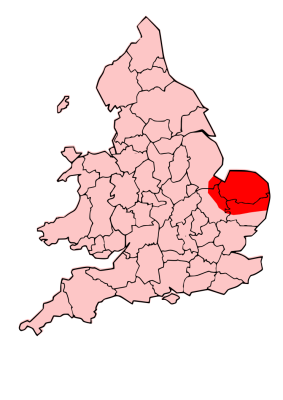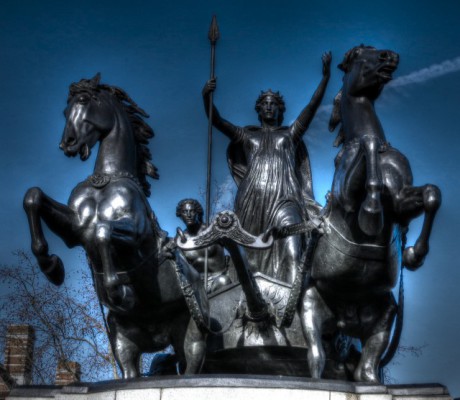
Recent Conquest
Boudica’s uprising came while Britain was still a relatively recent conquest. The second Roman invasion – and the first to succeed – came under the Emperor Claudius in 43 AD.With the arrival of the Romans less than a generation behind them, most people still remembered independence, and regarded the Romans as outside conquerors.
Britain was far from integrated into the Roman Empire. Many areas remained independent and resistant to Roman rule. Others were client kingdoms, affiliated with Rome but not yet part of its territories, their leaders still with half an eye on their way out.
Iceni Pride
Boudica was the wife of Prasutagus, King of the Iceni. A client kingdom since just after the initial conquest, the Iceni lived in the area that is now Norfolk, as well as parts of the counties surrounding it. The Iceni were a proud people who appear to have shared a strong sense of independent identity. Prasutagus himself had bucked the normal procedure for a client kingdom, in which Rome would inherit his kingdom on his death. Instead he made the Roman emperor co-heir to the Iceni kingdom, along with Boudica and their daughters. Prasutagus hoped to preserver his family line, and the Iceni hoped to preserve their independence.
Roman Greed
Resentment at the Romans was fired up by their behaviour following Prasutagus’s death. Aside from a political desire to desire to seize Iceni lands, and a financial desire to seize Prasutagus’s substantial wealth, the Romans had legal reasons for seizing control of Prasutagus’s kingdom. According to Roman law, women could not inherit, and property could not be passed through the female line. Boudican and her daughters were therefore ineligible to inherit.
Greed undoubtedly played its part. Iceni lands and property were confiscated. Nobles were treated as slaves. The procurator Catus Decianus – an administrator responsible for running the province – was particularly noted for his greed. Even individual financiers such as Seneca the Younger took the opportunity to recall loans.
According to Tacitus, the treatment went beyond greed and into cruelty. Boudica was flogged and her daughters raped as the Romans tried to break the Iceni spirit.

The Anglesey Campaign
Rebellion was already stirring against the Romans. The north Welsh island of Anglesey – then known as Mona – had become a refuge for rebels and for druids, the British priests who did much to maintain the spark of resistance. The Roman governor of Britain, Gaius Suetonius Paulinus, took his troops west to deal with Anglesey. With the Roman army far away, the Iceni and their neighbours gathered an army, led by Boudica. Making the most of the governor’s absence and thinner Roman military presence, they rose up in revolt.
Trinovantian Resentment
The resentment of other tribes against the Romans provided the Iceni with allies. In particular, the Trinovantes were angry at the invaders. Their capital of Camulodunum – now Colchester – had been turned into a Roman colony. Locals were mistreated by the settlers, and money was raised from local people to build a grand temple to the Emperor Claudius – a foreign god and the very man who had overseen Britain’s conquest. Boudica’s army fell upon Colchester, with support from local people. The last defenders held out for two days in the temple that had caused such resentment, but by the end the whole city had been burned to the ground.
Weak Initial Response

One mistake the inhabitants of Colchester made was looking to Catus Decianus for help. The procurator, whose own actions had triggered the revolt, sent only two hundred auxiliary troops to stop the rebel army. It was a weak response to a massive crisis, reflecting the hubris that characterised Decianus’s dealings with the Iceni.
Ninth Legion Massacre
One other attempt was made to save Colchester. Under the command of Quintus Petillius Cerialis, the 9th Legion marched toward the city while it was still under siege. Though the 9th Legion consisted of 5000 men, many were left holding other positions for which the legion was responsible. Several thousand men marched on Camulodunum, only to be defeated in open battle. Nearly all were killed, leaving the Romans militarily weaker and further damaging the credibility of their hold on Britain.
The Loss of London
Londinium – modern London – was a new city, founded by Roman settlers and traders on a crossing of the Thames. Already one of the most important settlements in Britain, if not the most important, it was a natural target for the rebels.
Unable to defend the city, Suetonius evacuated its inhabitants and left it to the mercy of the Iceni, who burned it to the ground. Two of the most significant Roman settlements in Britain had been destroyed.
Rebel Numbers
Suetonius finally mustered the forces available to him and faced Boudica’s army at an unknown location in the Midlands. He had perhaps four times the number of troops massacred outside Colchester. Though the exaggeration of ancient sources makes it impossible to accurately state the sizes of the armies, the Romans were clearly massively outnumbered. Boudica’s force may have numbered in the hundreds of thousands. Given different circumstances, or worse leadership than Suetonius provided, the Romans could easily have been destroyed, bringing Britain out of the empire. But Suetonius chose his ground well, so that the Britons could not use their weight of numbers. Superior Roman discipline and training triumphed, and the rebels were destroyed.
The location of Boudica’s defeat is unknown. Most historians favour a site in the West Midlands, somewhere along the Roman road now known as Watling Street. Kevin K. Carroll suggests a site close to High Cross in Leicestershire, on the junction of Watling Street and the Fosse Way, which would have allowed the Legio II Augusta, based at Exeter, to rendezvous with the rest of Suetonius’s forces, had they not failed to do so. Manduessedum (Mancetter), near the modern town of Atherstone in Warwickshire, has also been suggested, as has “The Rampart” near Messing in Essex, according to legend. More recently, a discovery of Roman artefacts in Kings Norton close toMetchley Camp has suggested another possibility,and a thorough examination of a stretch of Watling Street between St. Albans, Boudica’s last known location, and the Fosse Way junction has suggested the Cuttle Mill area of Paulerspury in Northamptonshire, which has topography very closely matching that described by Tacitus of the scene of the battle.
In 2009 it was suggested that the Iceni were returning to East Anglia along the Icknield Way when they encountered the Roman army in the vicinity of Arbury Bank, Hertfordshire. In March 2010, evidence was published suggesting the site may be located at Church Stowe, Northamptonshire
Lead image source
